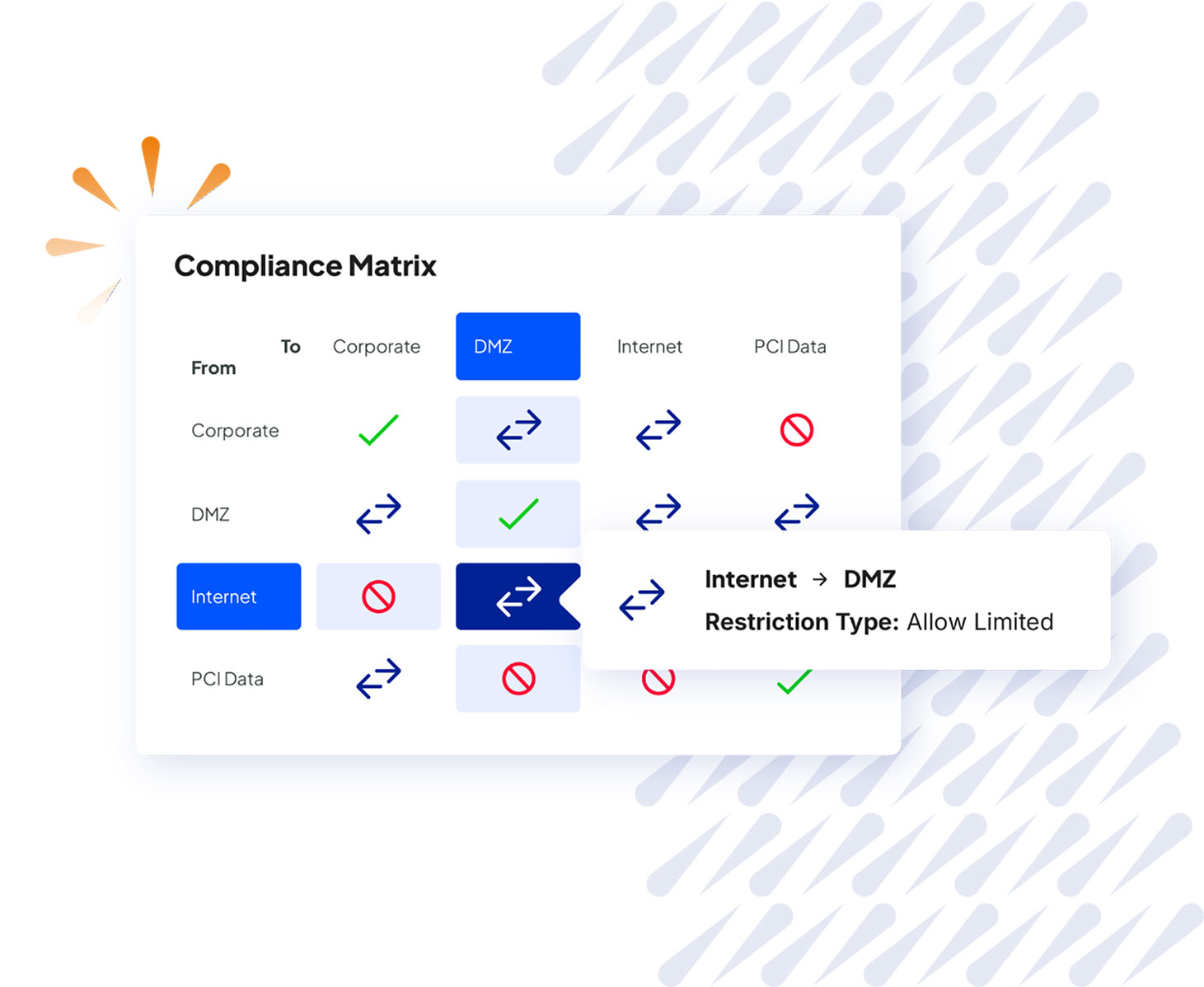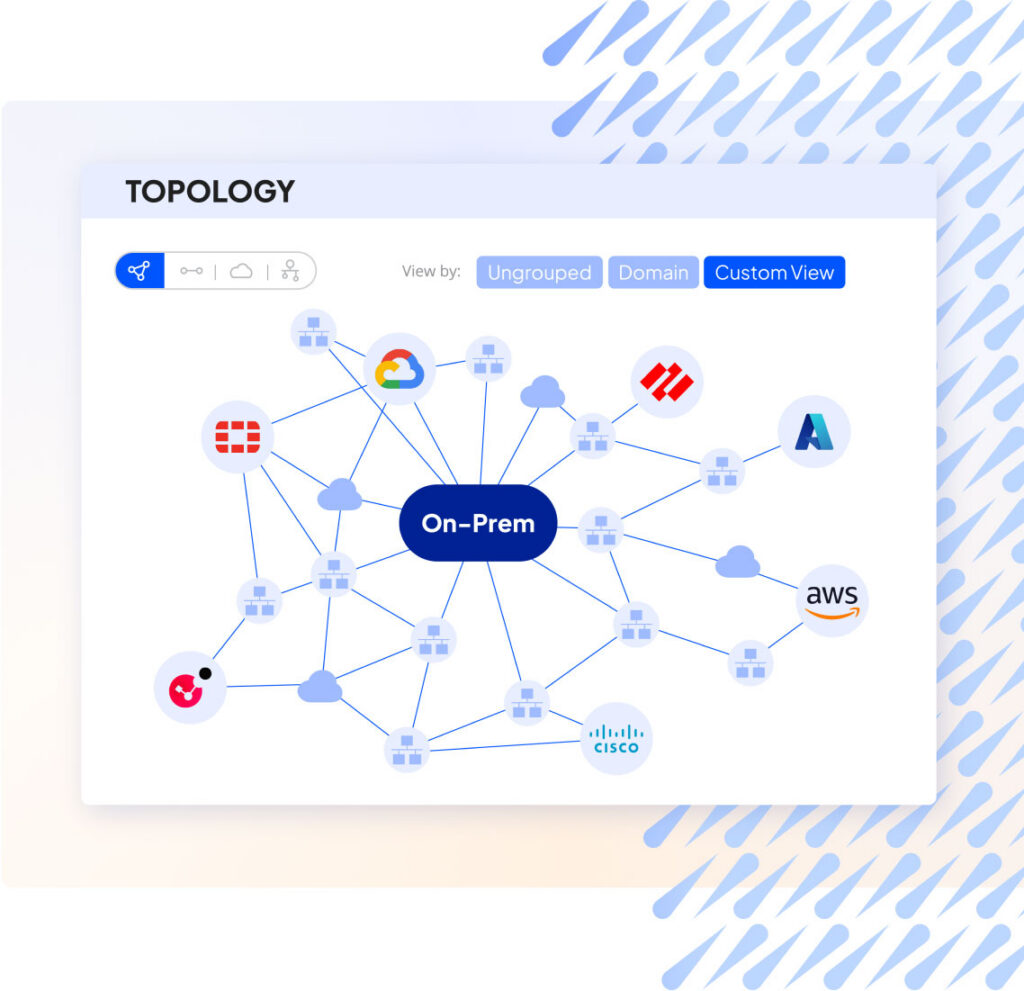Simplifying Your Network Complexity
Modern enterprise networks are complex, fast-changing, and fragmented. Traditional tools focus too narrowly on firewall rules or vulnerabilities, leaving security blind spots and unmanaged risk exposure. The result? Deployment delays, rising costs, and compliance failures — all of which increase the likelihood of a breach.
Simplified Posture Management
Tufin’s unified control plane for Network Security Posture Management (NSPM) unifies visibility, automates policy orchestration and provides continuous compliance risk across your hybrid network.
Full Attack Surface Visibility
Gain unified, real-time visibility across on-premises, cloud, and hybrid environments to eliminate blind spots and uncover hidden risks before attackers do.
Context-Aware Prioritization
Focus on the most critical exposures by combining vulnerability data, exploitability insights, and business context to drive smarter, faster remediation.
Automated Risk Response
Orchestrate and automate remediation across IT, security, and DevOps workflows to reduce mean time to respond (MTTR) and minimize business disruption.
Continuous Compliance
Continuously map and validate policies against frameworks like NIST, PCI DSS, DORA, and others with automated, audit-ready reporting that streamlines regulatory reviews.
Network Security Posture Management Use Cases

Why Tufin?
- Reduce Breach Risk: Continuously validate exposure paths and prioritize vulnerabilities with intelligent risk scoring to stop threats before they become incidents — protecting critical assets across hybrid and cloud environments.
- Accelerate Response: Automate remediation across IT, cloud, and DevOps workflows to reduce mean time to respond (MTTR) and limit business disruption from security incidents.
- Enhance Risk Visibility: Gain a real-time, unified view of your hybrid network — on-premises, cloud, and SASE — to eliminate security blind spots and make faster, more informed security decisions.
- Strengthen Compliance: Ensure continuous, verifiable compliance with automated policy validation and audit-ready reporting that aligns to internal standards and global frameworks like NIST, PCI DSS, and DORA — proving security posture at any moment.
- Lower Operational Costs: Streamline operations by replacing fragmented tools with a unified control plane, reducing manual work, complexity, and maintenance overhead while accelerating change delivery and time to value.
FAQs
Network security posture management is the continuous process of assessing and improving how secure an organization’s networks, cloud environments, and vulnerability management deployments are against potential threats. It involves detecting vulnerabilities, identifying misconfigurations, enforcing security policies, and ensuring access controls are applied consistently. By combining automation, continuous monitoring, and threat detection, organizations reduce security risks, safeguard sensitive data, and meet compliance frameworks like GDPR, HIPAA, PCI DSS, and NIST benchmarks.
Tufin provides real-time visibility into firewall and network security policies across hybrid and multi-cloud environments, helping security teams streamline policy management, enforce compliance, and quickly remediate security gaps.
- Conduct risk assessments to identify vulnerabilities, misconfigurations, and unauthorized access across cloud resources and on-premises networks
- Prioritize remediation based on the severity of security issues and compliance requirements like CIS benchmarks or GDPR mandates
- Implement automation and automated remediation workflows to reduce human error and accelerate incident response
- Apply strong access controls and permissions for endpoints, cloud workloads, and SaaS applications
- Use continuous monitoring and threat intelligence tools to detect malware, suspicious APIs, or compliance violations in real time.
With Tufin, security teams gain visibility and control across firewalls, cloud platforms like AWS, Azure, and Google Cloud. This ensures consistent enforcement of security policies and rapid remediation of risks before they lead to data breaches.
While they sound similar, Network Security Posture Management and Network Security Policy Management focus on different, but complementary aspects of securing the network.
Network Security Posture Management (NSPM) provides a broad, continuous view of your network’s overall security risk. It identifies exposures, misconfigurations, compliance gaps, and risky access paths across on-premises, cloud, and hybrid environments — helping security teams understand where they’re most vulnerable and how to reduce risk.
Network Security Policy Management (NSPM) focuses on defining, enforcing, and automating network security policies across firewalls, cloud, and hybrid infrastructures. It ensures every change, access request, and configuration aligns with security and compliance standards — helping teams act faster while maintaining control.
In short, posture management helps you see and assess network security risks, while policy management helps you enforce and automate the controls that fix it. Together, they provide a complete foundation for a secure, compliant, and resilient network.
Cloud Security Posture Management (CSPM) and Network Security Posture Management (NSPM) both aim to reduce risk and improve visibility — but they focus on different layers of your infrastructure.
Cloud Security Posture Management (CSPM) focuses specifically on cloud environments like AWS, Azure, and Google Cloud. It identifies and fixes misconfigurations in cloud-native services (such as storage buckets, IAM roles, or security groups) to ensure your cloud settings comply with best practices and regulatory frameworks.
Network Security Posture Management (NSPM) takes a broader, network-wide view. It analyzes and manages the security posture across on-premises, cloud, and hybrid network environments — including firewalls, routers, switches, and segmentation policies. NSPM looks at how everything connects, validating access paths, policies, and configurations across the entire network to uncover risk and compliance gaps.
In short, CSPM protects what’s inside the cloud, while NSPM protects how everything connects to and across it — giving you a unified view of risk and security posture across your entire infrastructure.
- Identify vulnerabilities by running ongoing risk assessments and aligning to CIS, NIST, or Gartner-endorsed benchmarks
- Automate remediation with workflows and security tools to reduce human error, accelerate incident response, and streamline enforcement
- Control permissions with least-privilege access controls to minimize unauthorized access to cloud platforms, SaaS, and IaaS workloads
- Adopt continuous monitoring to detect misconfigurations, malware, and potential threats in real time
- Harden data security to protect sensitive data and cloud resources with strong security measures and data protection policies
- Align with compliance by maintaining compliance monitoring for HIPAA, GDPR, PCI DSS, and other requirements
Tufin helps security teams maintain strong posture by automating firewall and network security policies, prioritizing remediation across multi-cloud environments, and enabling continuous compliance against industry and regulatory standards.
Additional Resources
Explore how Tufin correlates vulnerabilities with exploitability and business context to prioritize remediation of high-risk exposures.
Firewall Management Resources
Articles
Solutions
Get Started with Tufin
See how Tufin helps enterprises simplify complexity, lower breach risk, and strengthen compliance with Network Security Posture Management.





